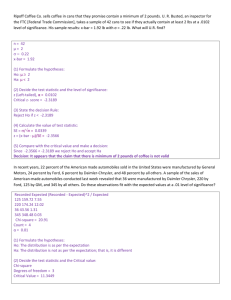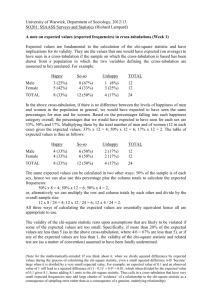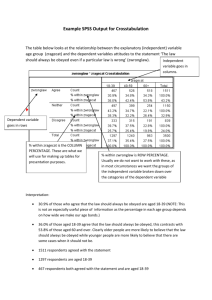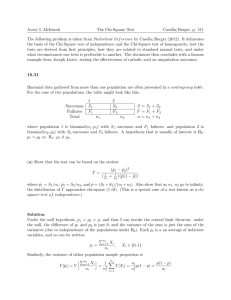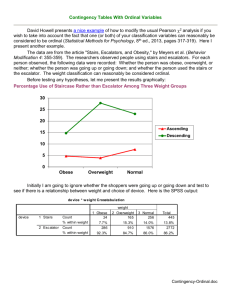AP Stats Chapter 10 Chi
advertisement
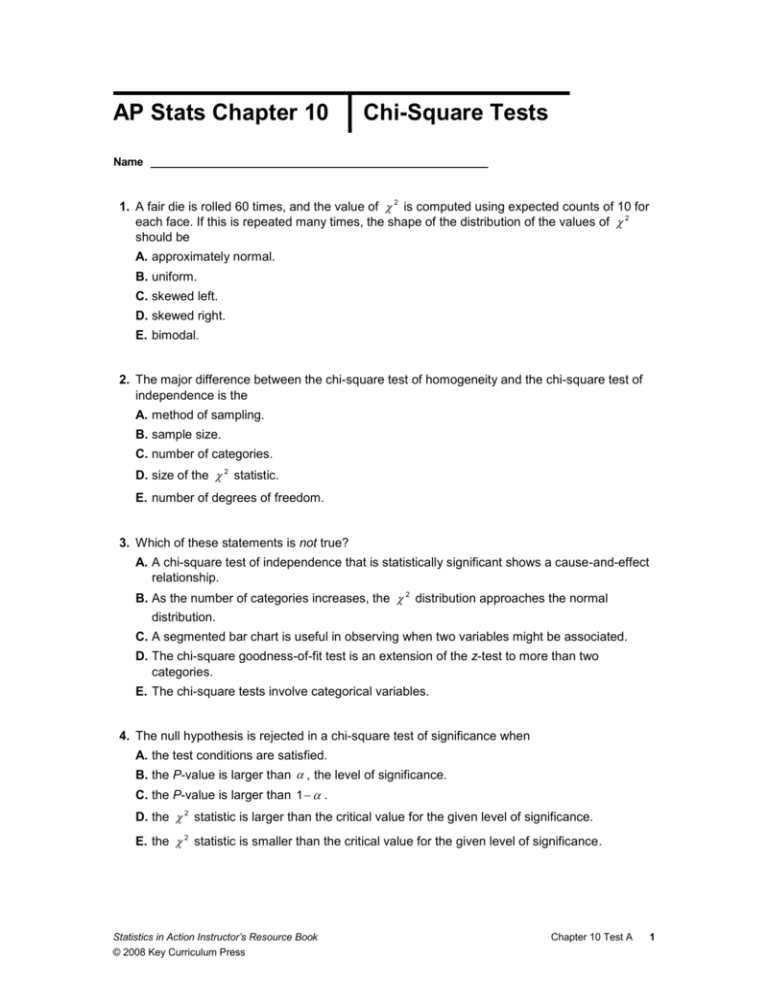
AP Stats Chapter 10 Chi-Square Tests Name ________________________________________________________ 1. A fair die is rolled 60 times, and the value of 2 is computed using expected counts of 10 for each face. If this is repeated many times, the shape of the distribution of the values of 2 should be A. approximately normal. B. uniform. C. skewed left. D. skewed right. E. bimodal. 2. The major difference between the chi-square test of homogeneity and the chi-square test of independence is the A. method of sampling. B. sample size. C. number of categories. D. size of the 2 statistic. E. number of degrees of freedom. 3. Which of these statements is not true? A. A chi-square test of independence that is statistically significant shows a cause-and-effect relationship. B. As the number of categories increases, the 2 distribution approaches the normal distribution. C. A segmented bar chart is useful in observing when two variables might be associated. D. The chi-square goodness-of-fit test is an extension of the z-test to more than two categories. E. The chi-square tests involve categorical variables. 4. The null hypothesis is rejected in a chi-square test of significance when A. the test conditions are satisfied. B. the P-value is larger than , the level of significance. C. the P-value is larger than 1 . D. the 2 statistic is larger than the critical value for the given level of significance. E. the 2 statistic is smaller than the critical value for the given level of significance. Statistics in Action Instructor’s Resource Book © 2008 Key Curriculum Press Chapter 10 Test A 1 5. Which test is appropriate for determining whether a random-digit generator is truly random in terms of the proportions of each digit it produces? A. the chi-square test of independence B. the chi-square test of homogeneity C. the chi-square goodness-of-fit test D. Either A or B is appropriate. E. None of these tests is appropriate. 6. Match the survey designs in parts a–c with the most appropriate chi-square test: goodness of fit, homogeneity, or independence. a. You are told that the number of cracked M&M’s depends on color. To check this claim, you randomly select 100 M&M’s of each color and count the number of cracked and uncracked M&M’s of each color. b. You are told that the distribution of M&M’s colors is as follows: 13% red, 16% green, 14% yellow, 20% orange, 24% blue and 13% brown. To check this claim, you randomly select a sample of M&M’s and count the number of M&M’s of each color. c. You are told that the number of cracked M&M’s depends on color. To check this claim, you randomly select 100 M&M’s and sort by color and whether the M&M is cracked or uncracked. 2 Chapter 10 Test A Statistics in Action Instructor’s Resource Book © 2008 Key Curriculum Press 7. A sociology class is interested in knowing whether there is a relationship between personality style and type of extracurricular activity. The class took a random sample of 200 students from a large high school and recorded these data. Personality Style Extrovert Type of Extracurricular Activity Normal Introvert Sports 21 44 25 Club 16 33 20 None 3 16 22 Using the standard four-step process: 1) type of test and check conditions; 2) state hypotheses; 3) compute test statistic with df and P-value and draw a sketch; 4) and write a conclusion in context; to perform a significance test on whether there is a relationship between personality style and type of extracurricular activity. Statistics in Action Instructor’s Resource Book © 2008 Key Curriculum Press Chapter 10 Test A 3 8. Suppose that 85% of all Americans are right-handed, 10% are left-handed, and 5% are ambidextrous. A random sample of 114 Mississippians includes 80 right-handers, 31 lefthanders, and 3 ambidextrous. Perform a significance test that the distribution of handedness for all Mississippians is the same as the distribution for all Americans, and what is the correct conclusion? Show all 4 steps of your process clearly. 4 Chapter 10 Test A Statistics in Action Instructor’s Resource Book © 2008 Key Curriculum Press 9. A pollster was hired by a television studio to take a random sample of 400 high school students, 100 from each of grades 9–12, and ask the students whether they watch at least one reality television show on a regular basis. The percentages that replied yes for grades 9, 10, 11, and 12 were 28%, 18%, 30%, 33%, respectively. The studio wishes to know whether there is evidence that the percentage varies among the grade levels. a. What significance test would you use for this design—a test of goodness of fit, homogeneity, or independence? Explain your choice. (You may want to create a 2-way table to look at what you know.) b. Perform the test you selected, showing all four steps. Statistics in Action Instructor’s Resource Book © 2008 Key Curriculum Press Chapter 10 Test A 5







